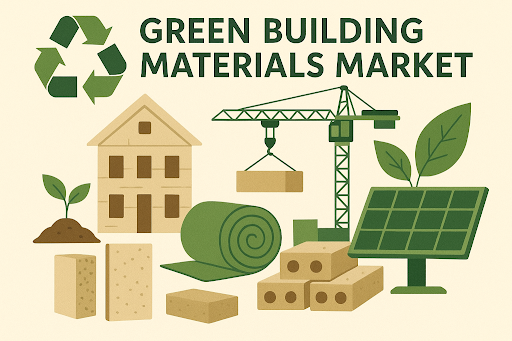
How Green Building Materials Are Powering the Future of Sustainable Construction
- Business
- October 2, 2025
- No Comment
The global construction industry is undergoing a transformative shift toward sustainability and energy efficiency. As climate change concerns intensify, builders, architects, and developers are increasingly adopting eco-conscious alternatives that minimize environmental impact. This movement has propelled the Green Building Materials Market, which was valued at USD 415.39 billion in 2024, to become one of the fastest-growing segments in the construction sector. According to forecasts, the market is expected to reach USD 1020.44 billion by 2032, registering a robust CAGR of 11.89% from 2025 to 2032.
The rapid expansion of green infrastructure, rising urbanization, and the adoption of environmental regulations worldwide are shaping the future of sustainable construction materials. From energy-efficient insulation and recycled steel to low-VOC paints and solar-integrated glass, the demand for eco-friendly building solutions is accelerating across residential, commercial, and industrial projects.
Market Growth Overview
The Green Building Materials Market is experiencing a surge in adoption due to growing global emphasis on sustainable development. Governments and private entities are investing heavily in green infrastructure projects aimed at reducing carbon emissions, conserving natural resources, and improving occupant health. This heightened focus on green certifications such as LEED (Leadership in Energy and Environmental Design), BREEAM (Building Research Establishment Environmental Assessment Method), and IGBC (Indian Green Building Council) is further encouraging the use of environment-friendly materials in construction.
Sustainable materials not only reduce energy consumption and water usage during the lifecycle of a building but also enhance durability and indoor air quality. The rising awareness among consumers about the environmental and economic benefits of green buildings is translating into higher market adoption across developed and emerging economies alike.
Key Market Drivers
1. Rising Environmental Regulations and Policies:
Governments around the world are implementing stringent environmental policies that promote the use of sustainable materials. Initiatives such as the European Green Deal, the U.S. Green Building Council’s LEED certification, and India’s Smart Cities Mission are pushing builders to prioritize eco-friendly materials.
2. Growing Urbanization and Infrastructure Projects:
The global rise in urban populations has led to an increasing number of construction projects. To meet housing and commercial demands sustainably, construction firms are integrating renewable and recycled materials to lower the carbon footprint of new developments.
3. Increased Focus on Energy Efficiency:
Energy-efficient buildings are becoming the norm rather than the exception. Green materials like reflective roofing, insulated wall systems, and smart glass significantly reduce energy consumption, making them essential for modern architecture.
4. Technological Advancements in Material Science:
Innovations in nanotechnology, 3D printing, and bio-based composites are creating new opportunities for sustainable construction. Companies are developing advanced materials that offer superior strength, insulation, and recyclability while minimizing waste.
5. Rising Consumer Awareness and Corporate Responsibility:
Eco-conscious consumers and corporations are increasingly favoring buildings that align with sustainability goals. Green-certified offices and homes are gaining popularity for their long-term cost savings and health benefits.
Emerging Trends Shaping the Market
The green construction movement is no longer limited to developed economies; emerging nations are rapidly embracing sustainable practices. Circular economy principles—focusing on reusing, recycling, and repurposing materials—are redefining how buildings are designed and constructed.
Moreover, digital transformation in construction, through Building Information Modeling (BIM) and smart monitoring systems, is helping reduce waste and optimize resource use. Materials like cross-laminated timber (CLT), hempcrete, and recycled steel are witnessing unprecedented demand due to their low embodied carbon and durability.
The hospitality, commercial, and institutional sectors are increasingly investing in net-zero energy buildings, further driving material innovation. As renewable energy integration becomes standard, solar-compatible roofing materials and energy-efficient windows are transforming the landscape of sustainable architecture.
Challenges and Opportunities
Despite its rapid growth, the Green Building Materials Market faces challenges such as high initial costs, lack of awareness in developing regions, and limited availability of specialized materials. However, as production scales up and technology evolves, costs are expected to decline, making sustainable construction more accessible.
Opportunities lie in expanding public-private partnerships and promoting government incentives for green infrastructure projects. Companies investing in R&D to create bio-based and recyclable materials will be well-positioned to lead the market in the coming years.
Conclusion
The global shift toward sustainability is reshaping how we build our homes, offices, and cities. With supportive policies, technological innovation, and rising environmental awareness, the Green Building Materials Market is on a remarkable trajectory toward exceeding USD 1020.44 billion by 2032. As construction firms embrace green technologies, the future of urban development promises to be cleaner, smarter, and more sustainable.
The ongoing transformation is not merely a trend—it’s a necessity for addressing climate challenges and achieving long-term ecological balance. Just as seen in other industries adapting sustainable models, the construction sector’s evolution underscores the importance of environmental stewardship, much like the growth pattern witnessed in the Chemical as a Service Market.
FAQs
Q1: What is the CAGR of the Green Building Materials Market during 2025–2032?
The market is projected to grow at a CAGR of 11.89% during the forecast period from 2025 to 2032.
Q2: What is the forecast period covered for the Green Building Materials Market?
The forecast period spans from 2025 to 2032, with projections based on industry trends, investments, and sustainability initiatives.Q3: Which regions are expected to witness the highest growth in the Green Building Materials Market?
Regions such as North America, Europe, and the Asia-Pacific are expected to experience the fastest growth, driven by green construction mandates and rapid urbanization.



